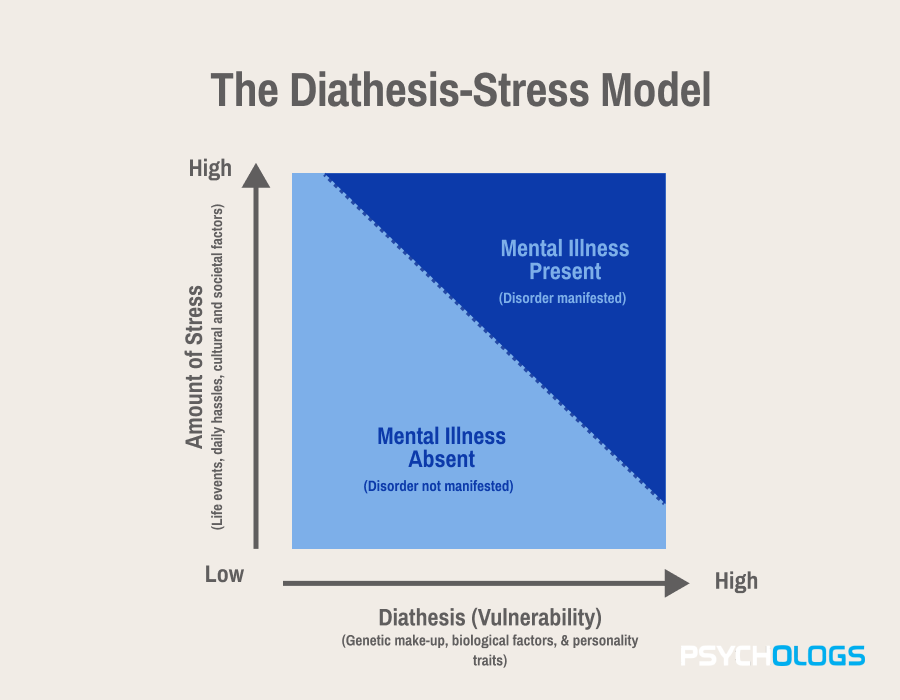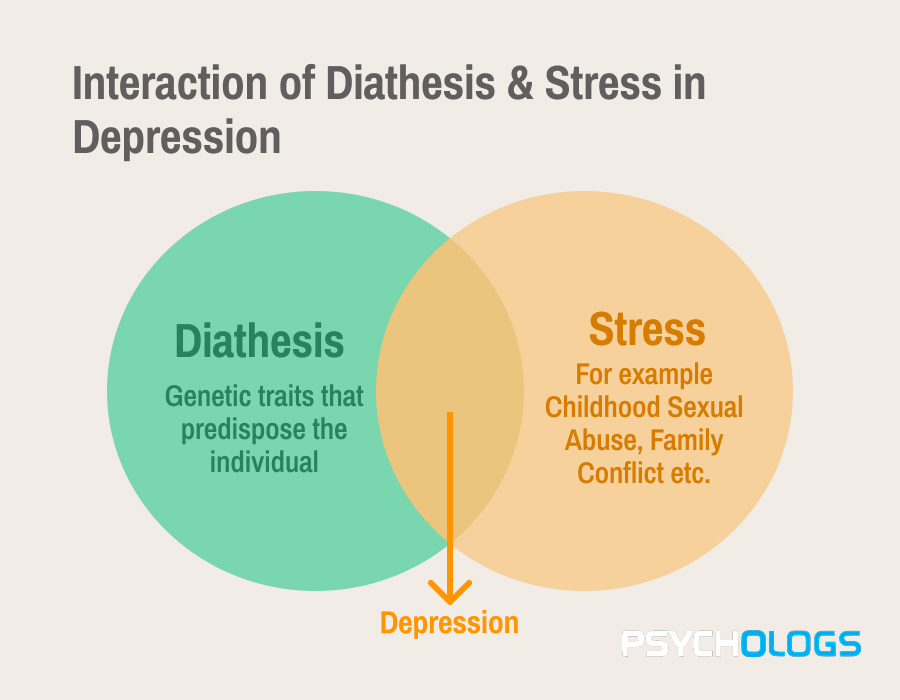Psychological research has given much attention to factors that affect mental health conditions. However, over the years, various psychological models have been used to explain psychological disorders, which include the biological model (Schwartz & Corcoran, 2010), psychodynamic model (Strieker & Gold, 1988), cognitive-behavioural model (Hofmann, 2014), and the humanistic-existential model (Frankl, 2024). In addition to these, the diathesis-stress model is also one of the most significant theories that assist in understanding the occurrence of most psychological conditions (Salomon & Jin, 2020).


According to the diathesis stress model, mental health conditions are highly determined by some vulnerabilities or predispositions present in an individual.
Such vulnerabilities are biological factors such as brain structures, genetic, chromosomal abnormalities and hormonal imbalances, etc., psychological factors like family history of mental disorders, trauma, etc., and even environmental factors including lack of nutrition, life events such as death, abuse, illness, feeling of alienation, and other factors like financial and economic struggles.
In combination with a high level of stress, such predispositions can initiate a mental health condition. This model has aided in both learning the development of disorders such as PTSD, depression, anxiety and schizophrenia and facilitated the improvement of diagnosis and treatment. A key fact to keep in mind concerning the model is that the stressor activates the diathesis, which triggers the disorder, and neither the diathesis nor the stressor alone is sufficient to cause a mental health disorder (Salomon & Jin, 2020).
The model is also used to explain why an individual experiences a mental health condition, whereas other people might be resilient to the stressful circumstances. For example, a person with a family history of depression is not bound to have any symptom unless he/she is going through a stressful event such as loss of a loved one or a divorce etc. but another person who did not have such a history might have the mental strength to get over the loss or pain (Salomon & Jin, 2020).
Historical Background
The foundational idea for the diathesis stress model is said to come from the 1800s. This model was known as the predisposition-excitation framework (PEF), which described two reasons for mental illness. The predisposing causes, which include heredity, gender, occupation, education, etc. and the exciting causes were sudden life-altering events like trauma, substance abuse, physical injury, etc.
This model considered that small stressors, when accumulated and correspond with certain vulnerability, lead to the disintegration of mental health. However, PEF had limitations such as considering stressors to be only environmental factors and vulnerabilities to be internal to a person, and it offered incomplete reasoning for mental health conditions (Kendler, 2020). To overcome these limitations, the diathesis–stress model was developed.
Application for Diathesis-Stress Model
This model explains the development and further treatment, and management of mental conditions:
Depression
Recent research supports that the diathesis-stress model can explain depression as a combined result of both stressful events and vulnerabilities like biological, psychological and environmental factors (Martin & Larkin, 2018, p. 10).


A study found that individuals with a high polygenic risk score for depressive disorder and multiple life stressors were more likely to develop symptoms. (Colodro Conde et al., 2019). Another study highlighted the occurrence of depressive symptoms among adolescents using the diathesis model, suggesting that stress with societal factors can lead to depression. The study signifies that factors like parental rejection are an important social vulnerability in early adolescence, which decreases with age and during the middle and late teenage years, when adolescents show peer rejection as the central vulnerability (Braet et al., 2012).
Post Traumatic Stress Disorder (PTSD)
Research on understanding PTSD have shown that while trauma itself is the primary cause for the condition, it is not the only factor responsible for developing PTSD but rather certain biological and ecological vulnerabilities, like genetics, life events, environment etc. interacts with the trauma there by developing PTSD (McKeever & Huff, 2003). The more risk factors an individual possesses, along with the intensity of trauma, the lower their threshold for resilience against stressors, thereby increasing the risk of PTSD. This approach strengthens understanding and guides better prevention and intervention strategies for trauma-related disorders (Elwood et al., 2008).
Anxiety
In the case of anxiety disorders, the diathesis-stress model showed that children who have behavioural inhibition (diathesis) and experience a high level of stress have an increased symptom of anxiety. While other children who did not have this predisposition and had normal levels of stress exhibited decreased symptoms (Brozina & Abela, 2005). Another study considered personality traits such as neuroticism to be a diathesis which, when interacted with stressors, can cause or increase psychological disorders like mood disorders, depression and particularly anxiety (Yang et al., 2022).
Schizophrenia
Schizophrenia was one of the first disorders analysed by Paul Meehl using the diathesis method. Further, Manfred Bleuler stated that genetics is not the sole factor in schizophrenia but rather external environmental influences, along with heredity, increase the risk of psychotic conditions (Kendler, 2020). For instance, abuse or an injury can cause hormonal imbalances along the Hippocampus-Pituitary-Adrenal (HPA) axis in addition with changes in brain structure and once an individual passes the threshold level of resilience against stressors, they are in risk of developing schizophrenia and other psychiatric conditions (Cheng et al., 2016; Pruessner et al., 2016).
Advantages of the Diathesis Stress Model
The diathesis stress model has significantly changed how researchers and therapists understand disorders. Previous models considered disorders as a result of either genetics or environmental factors; however, the diathesis model explores a more combined effect of nature and nurture, along with other influences in developing a psychological condition. Moreover, it also emphasises the significant impact of stress and its interaction with the risk factors on mental health (Broerman, 2017).
The model’s usefulness extends to developing better treatment and early intervention strategies. As shown in the PTSD study, the model helps therapists and clinicians to focus on the predisposition and apply the appropriate intervention for the trauma. It also helps to develop early prevention plans and identification for potentially similar cases (Elwood et al., 2008).
Disadvantages of the Diathesis-Stress Model
The model oversimplifies the reasoning of an individual suffering from a mental health condition.
Many researchers do not agree with the model as it doesn’t offer enough criteria to explain all disorders. Additionally, the model is not static and varies with individual differences. For instance, some individuals may suffer from one stressful event to prompt the disorder, while some may have a higher resilience level (Elwood et al., 2008). The diathesis model also doesn’t explain how some individuals with no genetic or environmental pre-existing vulnerabilities can still develop a psychological disorder (Elwood et al., 2008).
Conclusion
The diathesis stress model can help understand the interaction between vulnerability factors within individuals and environmental stressors that lead to the development of mental health conditions. Its integrative approach promotes more specific prevention, diagnosis and intervention in various psychological disorders.
FAQs
1: What is the diathesis-stress model?
The diathesis stress model explains how individuals’ pre-existing vulnerabilities (diathesis) interact with stressors to cause mental health conditions.
2: What is meant by “diathesis” in the model?
Diathesis refers to a person’s vulnerability or predisposition, which, when it interacts with a stressor, gets triggered to cause a mental disorder.
3: How does “stress” factor into the model?
Stress in the diathesis model refers to some social and environmental factors that can cause or aid in worsening mental health conditions.
4: What are some examples of mental disorders explained by the diathesis-stress model?
Some examples of mental disorders are depression, anxiety, schizophrenia and PTSD.
5: Does the model suggest that diathesis is always genetic?
No, the model states that diathesis can be genetic, psychological, or social vulnerabilities that tend to cause or worsen a disorder.
References +
- Braet, C., Leen Van Vlierberghe, Vandevivere, E., Lotte Theuwis, & Bosmans, G. (2012). Depression in Early, Middle and Late Adolescence: Differential Evidence for the Cognitive Diathesis–Stress Model. Clinical Psychology & Psychotherapy, 20(5), 369–383. https://doi.org/10.1002/cpp.1789
- Broerman, R. (2017). Diathesis-Stress Model. Springer EBooks, 1–3. https://doi.org/10.1007/978-3-319-28099-8_891-1
- Brozina, K., & Abela, J. R. Z. (2005). Behavioural inhibition, anxious symptoms, and depressive symptoms: A short-term prospective examination of a diathesis-stress model. Behaviour Research and Therapy, 44(9), 1337–1346. https://doi.org/10.1016/j.brat.2005.09.010
- Cheng, S. C., Walsh, E., & Schepp, K. G. (2016). Vulnerability, Stress, and Support in the Disease Trajectory from Prodrome to Diagnosed Schizophrenia: Diathesis–Stress–Support Model. Archives of Psychiatric Nursing, 30(6), 810–817. https://doi.org/10.1016/j.apnu.2016.07.008
- Colodro Conde, L., Couvy-Duchesne, B., Zhu, G., Coventry, W., Byrne, E., Gordon, S., Wright, M., Montgomery, G., Madden, P., Ripke, S., Eaves, L., Heath, A., Wray, N., Medland, S. E., & Martin, N. (2019). A direct test of the diathesis–stress model for depression. European Neuropsychopharmacology, 29(7), S805–S806. https://doi.org/10.1016/j.euroneuro.2017.08.045
- Elwood, L. S., Hahn, K. S., Olatunji, B. O., & Williams, N. L. (2008). Cognitive vulnerabilities to the development of PTSD: A review of four vulnerabilities and the proposal of an integrative vulnerability model. Clinical Psychology Review, 29(1), 87–100. https://doi.org/10.1016/j.cpr.2008.10.002
- Frankl, V. E. (2024). On the Theory and Therapy of Mental Disorders. In Routledge eBooks. Informa. https://doi.org/10.4324/9781003401896
- Hofmann, S. G. (2014). Toward a Cognitive-Behavioral Classification System for Mental Disorders. Behavior Therapy, 45(4), 576–587 https://doi.org/10.1016/j.beth.2014.03.001
- Kendler, K. S. (2020). A Prehistory of the Diathesis-Stress Model: Predisposing and Exciting Causes of Insanity in the 19th Century. American Journal of Psychiatry, 177(7), 576–588. https://doi.org/10.1176/appi.ajp.2020.19111213
- Martin, C. R., & Larkin, D. (2018). Probiotics in Mental Health (1st ed., p. 10). CRC Press
- McKeever, V. M., & Huff, M. E. (2003). A Diathesis-Stress Model of Posttraumatic Stress Disorder: Ecological, Biological, and Residual Stress Pathways. Review of General Psychology, 7(3), 237–250. https://doi.org/10.1037/1089-2680.7.3.237
- Pruessner, M., Cullen, A. E., Aas, M., & Walker, E. F. (2016). The neural diathesis-stress model of schizophrenia revisited: An update on recent findings considering illness stage and neurobiological and methodological complexities. Neuroscience & Biobehavioral Reviews, 73, 191–218. https://doi.org/10.1016/j.neubiorev.2016.12.013
- Salomon, K., & Jin, A. (2020). Diathesis-Stress Model. Springer EBooks, 655–657. https://doi.org/10.1007/978-3-030-39903-0_797
- Schwartz, S., & Corcoran, C. (2010). Biological theories of psychiatric disorders: A sociological approach. A Handbook for the Study of Mental Health,, 64-88.
- Strieker, G., & Gold, J. R. (1988). A Psychodynamic Approach to the Personality Disorders. Journal of Personality Disorders, 2(4), 350–359. https://doi.org/10.1521/pedi.1988.2.4.350
- Ungvarsky, J. (2024). Diathesis–stress model | EBSCO. EBSCO Information Services, Inc. | Www.ebsco.com. https://www.ebsco.com/research-starters/psychology/diathesis stress-model
- Yang, X. Y., Morton, P., Yang, F., & Fang, B. (2022b). The Moderation Role of Neuroticism for Anxiety among Burdened Dementia Caregivers: A Study on Care Giver-Recipient Dyads. Journal of Gerontological Social Work, 65(7), 1–19. https://doi.org/10.1080/01634372.2021.2019164







Leave feedback about this